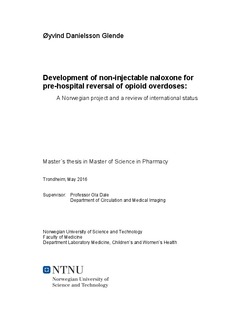| dc.description.abstract | Background and aims: Per year, overdoses kill 69.000 users of illicit and prescription opioids in epidemic pattern worldwide. Among them, 250 people in Norway. Naloxone is an effective antidote for opioid overdose reversal, but approved pharmaceuticals have been limited to invasive administrations. Lay people access to naloxone is initiated to facilitate bystander rescue, but limitations associated with invasive administration constitute a desire for non-injectable formulations. The thesis deals with two separate issues: A) Contribution to recruitment, screening and conduction of a pivotal clinical trial aiming to support marketing authorization for an intranasal naloxone spray. B) Contribution to a systematic review paper on non-peer reviewed patent registrations of non-injectable naloxone formulations. Method: A) Central elements of good clinical practice were dealt with through developing documents needed for recruitment and inclusion to the clinical trial. B) Patents on noninjectable naloxone formulations were identified through the WIPO PatentScope database. Information on pharmacokinetics and formulations (including stability data) were extracted and analysed. Peer-reviewed literature was reviewed based on a PubMed search using the Boolean search query “(nasal OR intranasal OR nose OR buccal OR sublingual) AND naloxone AND pharmacokinetics”. Results: A) An Information letter with an integrated informed consent form, blood sample storage records, an information flyer and a case report form were developed and used during recruitment and at screening in October and November 2015. 17 subjects were screened, whereof 11 were eligible. 6 subjects were re-screened and 9 new subjects were screened at March 2016, whereof 12 subjects were included. B) 522 WIPO patents and 56 PubMed records were identified, whereof 3 patents and 5 papers were eligible. Pharmacokinetic data for intranasal and sublingual routes were identified and collated. Sublingual bioavailability was F=1%. For concentrated intranasal formulations, bioavailability relative to intravenous and intramuscular were in the range of F=21-42% and FIM=26-57%, and for non-concentrated intranasal naloxone F=11% and FIM=10%, respectively. Intranasal bioavailability is associated positively with dose and negatively with volume. In summary: A) Taking part in the preparation of a clinical trial on pharmaceuticals will enhance the understanding of good clinical practice, general research and medical ethics principles. B) It is possible to obtain valuable scientific knowledge in the field of development of non-injectable naloxone outside the peer-reviewed literature through a systematic review of registered patents | nb_NO |
